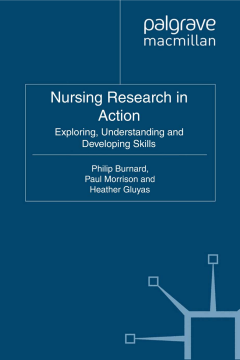
Additional Information
Book Details
Abstract
Written by highly experienced researchers and authors, this practical workbook demystifies the research process for nursing students and practitioners. Fully updated to incorporate recent technological developments, this new edition features a range of exercises to both challenge and support the budding nurse researcher.
PHILIP BURNARD is Emeritus Professor of Nursing at Cardiff University, Wales, UK. He is the author of many books and papers and has taught internationally. His research interests have included interpersonal skills and counselling, stress and culture in nursing. He continues to work with colleges and universities around the world.
PAUL MORRISON is Dean of School of Nursing and Midwifery, Murdoch University, Perth, Australia. He has a long-standing interest in the mental health area and the education of health professionals. A major focus of his research over the years has been the evaluation of services for consumers. More recently he has published a number of papers in the area of health promotion. Paul also works as a psychologist in private practice in Canberra. He is a Chartered Psychologist and an Associate Fellow of the British Psychological Society.
HEATHER GLUYAS is Associate Professor and Deputy Dean of School of Nursing and Midwifery, Murdoch University, Perth, Australia.
"Clear, concise text - highly applicable to current nursing research"
- Jeanne Landon-Campbell, School of Nursing and Midwifery, Cumbria University, UK
'This is an excellent starting point for nursing students, as well as a refresher for practitioners and those undertaking postgraduate research.' - Nursing Standard
Table of Contents
| Section Title | Page | Action | Price |
|---|---|---|---|
| Cover | Cover | ||
| Half title | i | ||
| Title | iii | ||
| Copyright | iv | ||
| Dedication | v | ||
| Brief Contents | vii | ||
| Contents | ix | ||
| List of Figures and Tables | xii | ||
| Preface | xiii | ||
| Acknowledgements | xix | ||
| About the Authors | xx | ||
| Chapter 1 An Overview of the Research Process | 1 | ||
| Introduction | 1 | ||
| Definitions of research | 3 | ||
| Examples of nursing research | 5 | ||
| Stages of the research process | 8 | ||
| Planning a research project | 11 | ||
| Chapter 2 Planning Your Research Project | 15 | ||
| Introduction | 15 | ||
| Clarifying research problems and questions | 16 | ||
| Writing a research proposal | 23 | ||
| Identifying constraints | 26 | ||
| Chapter 3 Searching the Literature | 29 | ||
| Introduction | 29 | ||
| Exploring the literature resources | 30 | ||
| Finding relevant literature | 32 | ||
| Keeping track of your references | 35 | ||
| Critically reviewing the literature | 39 | ||
| Writing a literature review | 43 | ||
| Chapter 4 Approaches to Research Methodology | 46 | ||
| Introduction | 46 | ||
| The differences between quantitative andqualitative research | 47 | ||
| Descriptive and experimental research | 50 | ||
| Subjectivity and objectivity in research | 53 | ||
| The researcher’s choice of methodology | 54 | ||
| Chapter 5 Choosing a Research Method | 57 | ||
| Introduction | 57 | ||
| The concept of research design | 58 | ||
| Making decisions about methods | 62 | ||
| Sampling methods | 66 | ||
| Chapter 6 Methods of Collecting Data | 69 | ||
| Introduction | 69 | ||
| Interviews | 70 | ||
| Questionnaires | 76 | ||
| Questionnaire construction | 78 | ||
| Experiments | 81 | ||
| Observation | 83 | ||
| Use of existing records | 87 | ||
| Repertory grid technique | 89 | ||
| Critical incident technique | 91 | ||
| Multiple sorting technique | 93 | ||
| Use of existing scales, inventories, tests andassessment tools | 95 | ||
| Delphi Method | 96 | ||
| Chapter 7 Choosing a Data Collection Method | 99 | ||
| Introduction | 99 | ||
| Identifying a range of availabledata collection methods | 100 | ||
| Choosing your data collection method | 101 | ||
| Choosing your method of data analysis | 102 | ||
| Chapter 8 Methods of Analysing Data | 106 | ||
| Introduction | 106 | ||
| Quantitative analysis | 107 | ||
| Qualitative analysis | 117 | ||
| Exploring qualitative analysis | 118 | ||
| Using quantitative and qualitative approachesin the same study | 122 | ||
| Software for analysis | 123 | ||
| Chapter 9 Undertaking the Research Project | 125 | ||
| Introduction | 125 | ||
| Time management | 126 | ||
| Supervision of your research project | 130 | ||
| A note about supervision | 131 | ||
| A checklist for achieving good research supervision | 132 | ||
| Chapter 10 Writing the Research Report | 135 | ||
| Introduction | 135 | ||
| Planning your research report | 136 | ||
| Writing your report | 138 | ||
| Writing for publication | 141 | ||
| Submitting work for consideration for publication | 144 | ||
| References | 146 | ||
| Index | 153 |
